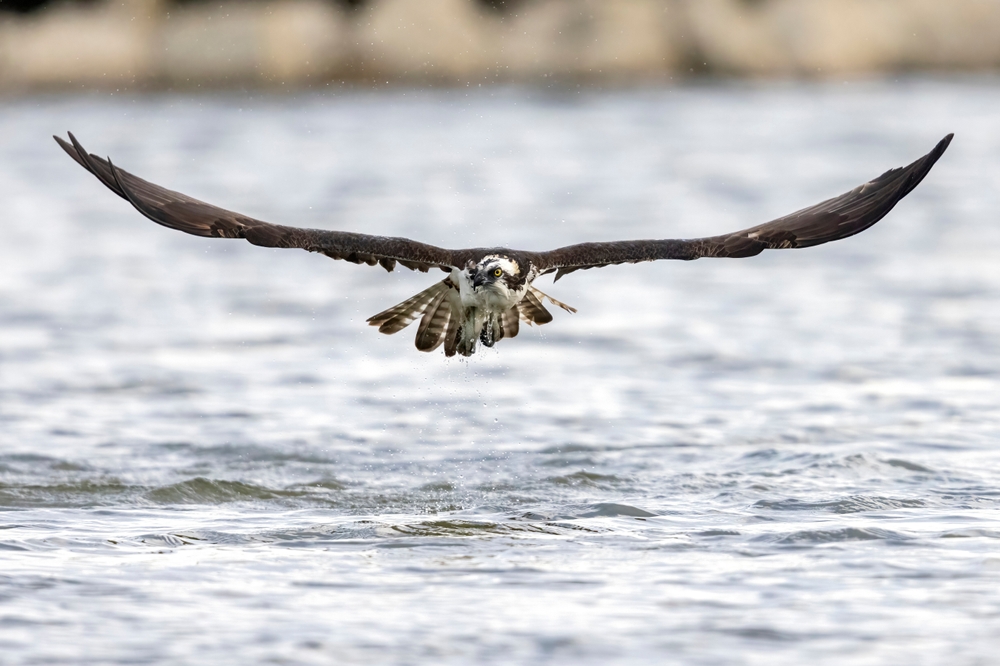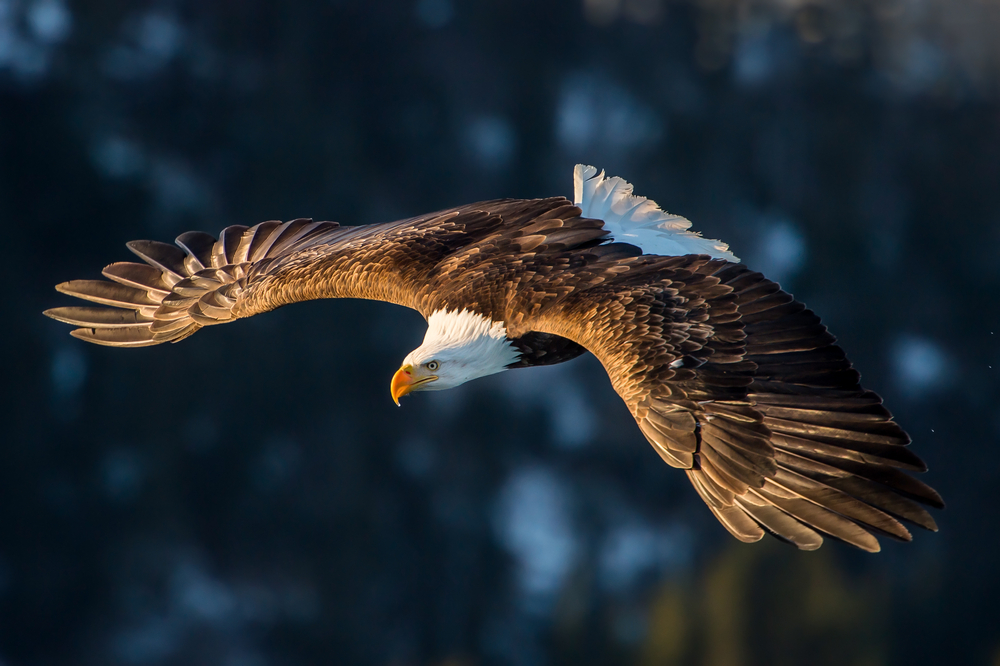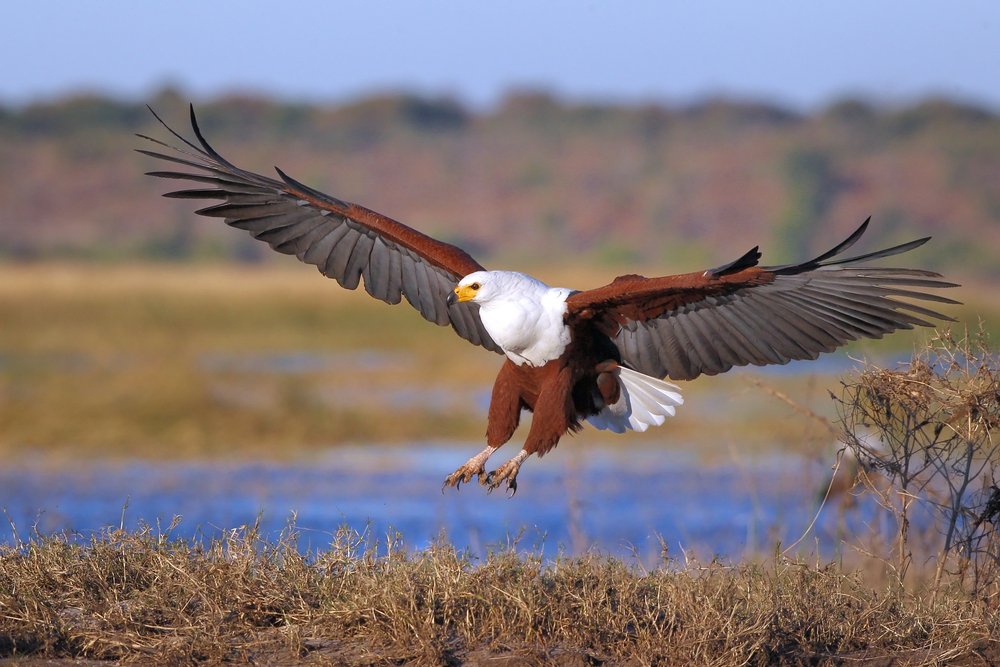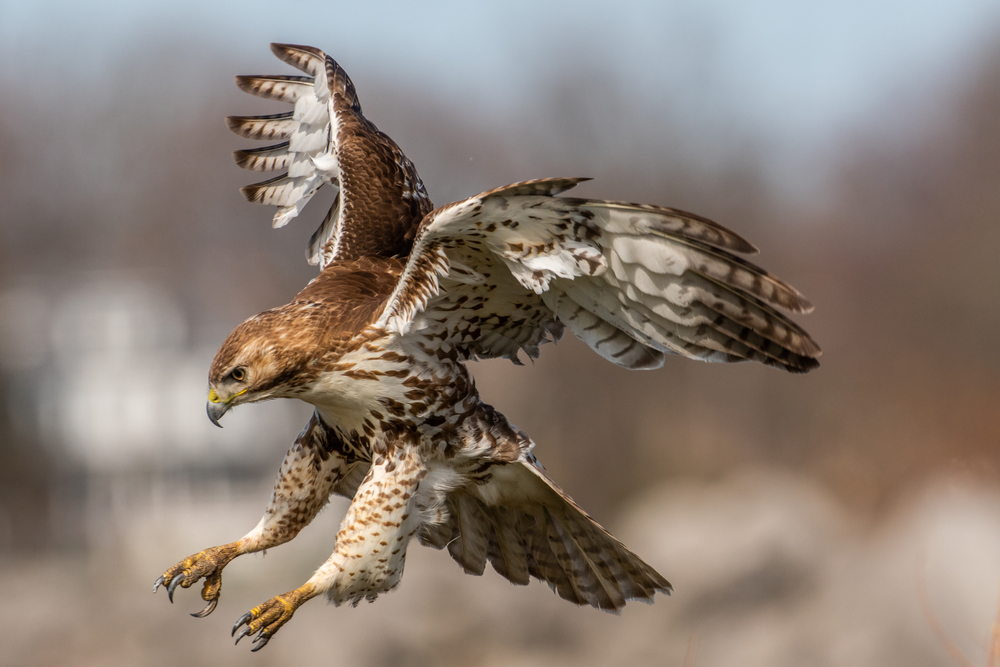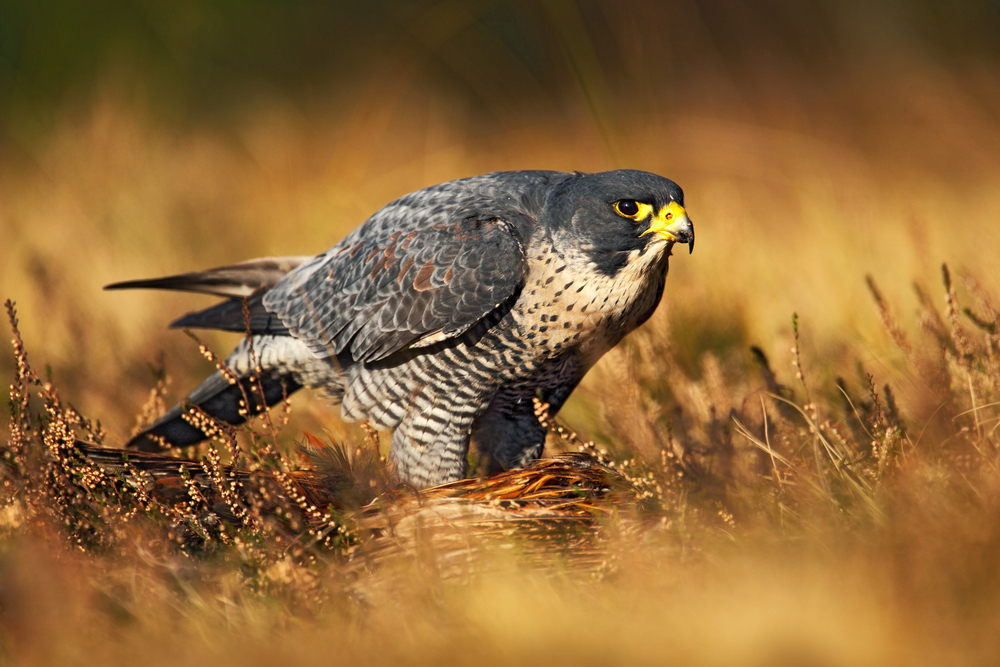The Osprey (Pandion haliaetus) is unique in that it is the only living member of its family, Pandionidae. While it shares some traits with hawks and eagles, it is not directly close to any of them taxonomically.
About
The Osprey (Pandion haliaetus) is a distinctive fish-eating raptor found on every continent except Antarctica. It is the sole living member of the family Pandionidae, setting it apart from other hawks and eagles. This wide-ranging bird is often seen near rivers, lakes, reservoirs, and coastal areas, where it soars and hovers above water before plunging feet-first to snatch fish with its powerful talons.
Ospreys are medium-to-large raptors, measuring 50–66 cm (20–26 in) in length with an impressive wingspan of 127–180 cm (50–71 in). They have long, narrow wings that bend at the “wrist,” creating a distinct M-shape in flight. Their plumage is a striking contrast of dark brown upperparts and white underparts, with a dark eye stripe running across the face. Adapted specifically for fishing, they possess reversible outer toes and barbed pads on their feet that help grip slippery prey. Fish make up over 99% of their diet, making the Osprey one of the most specialized raptors in the world.
Breeding pairs are monogamous and often return to the same nesting sites year after year. Nests, called eyries, are large stick platforms built on tall trees, cliffs, or increasingly on human-made structures such as poles, towers, and platforms provided for conservation purposes. The female lays 2–4 eggs, and both parents take part in incubation and chick rearing. Young Ospreys fledge at around seven to eight weeks old but may remain dependent for several more weeks.
The Osprey is migratory in many parts of its range, traveling thousands of kilometers between breeding and wintering grounds. Despite past population declines due to pesticides like DDT, strong conservation efforts have helped the species rebound. Today, Ospreys are considered a conservation success story, admired worldwide for their resilience, dramatic fishing dives, and global presence.
Physical Characteristics
Plumage:
The Osprey (Pandion haliaetus) is a large fish-eating raptor with a striking appearance. Its plumage is mostly dark brown above and white below, providing camouflage both from above and below. The head is largely white, marked with a distinctive dark eye stripe that runs from the beak through the eye to the nape.
Head:
The head is bold white with the dark streak giving it a masked look. The beak is sharply hooked and black, designed for gripping and tearing fish. Its eyes are a vivid yellow to orange, specialized for spotting prey beneath the water’s surface.
Body:
The Osprey’s body is streamlined and lightweight for its size, perfectly adapted for aerial dives. The underside is white, sometimes marked with a necklace of brown streaks across the chest, more pronounced in females.
Size:
-
Length: 20–26 in (50–66 cm)
-
Wingspan: 59–71 in (150–180 cm)
-
Weight: 2.0–4.6 lbs (0.9–2.1 kg), with females generally larger than males
Feet & Talons:
The Osprey has uniquely adapted feet for catching fish:
-
Reversible outer toe that allows it to grasp prey with two toes in front and two in back, improving grip.
-
Sharp, curved talons and spiny foot pads help secure slippery fish.
Flight Style:
Recognized by its long, narrow wings with distinct bends at the “wrist,” the Osprey soars effortlessly and hovers above water before plunging feet-first into the water to snatch prey.
Tail:
The tail is barred with dark bands and is used as a rudder during dives and hovering flight.
The Osprey’s physical features are highly specialized for its fish-based diet, making it one of the most distinctive raptors worldwide, often seen near lakes, rivers, and coastlines.
Reproduction
Breeding Season:
Ospreys breed in the spring and summer months, with timing depending on latitude. In North America and Europe, breeding typically begins from March to June, while tropical populations may nest year-round.
Courtship:
Males perform spectacular aerial displays, often carrying a fish or nesting material in their talons while calling to attract or reassure a mate. Pairs are generally monogamous and often reunite at the same nesting site year after year.
Nesting:
-
Nests are large stick platforms, often placed on cliffs, tall trees, or man-made structures like utility poles and nesting platforms near water.
-
Nests are reused annually and added to, sometimes reaching several feet across after many years.
-
The nest cup is lined with softer material such as grasses, seaweed, or moss.
Eggs:
-
A clutch usually contains 2 to 4 eggs.
-
Eggs are cream to buff colored, speckled with reddish-brown blotches.
Incubation:
-
Lasts 36 to 42 days.
-
The female performs most of the incubation, while the male provides food.
Chick Development:
-
Chicks hatch asynchronously, meaning the first chick may be larger and stronger than later ones.
-
Both parents feed the nestlings, tearing fish into small pieces.
-
Fledging occurs at about 7 to 8 weeks of age, though young remain dependent on parents for food and hunting practice for several more weeks.
Maturity:
-
Juveniles usually migrate at the end of the season and may spend 2 to 3 years in their wintering grounds before returning to breed.
-
Sexual maturity is generally reached at 3 to 4 years of age.
The Osprey’s reproductive cycle reflects its reliance on stable nesting sites near water and abundant fish populations, with strong pair bonds and high nest-site fidelity ensuring breeding success.
Lifespan
In the Wild:
Ospreys typically live 15 to 20 years in their natural habitats. Many do not survive their first year due to predation, accidents during migration, or lack of hunting experience, but those that reach adulthood can live long lives thanks to their specialized adaptations and wide distribution.
In Captivity:
With veterinary care, consistent food, and protection from hazards, Ospreys may live slightly longer, sometimes exceeding 25 years.
Record Lifespan:
The oldest known wild Osprey lived to be over 32 years old, a rare but documented case.
Threats to Longevity:
-
Predation: Eggs and chicks are vulnerable to raccoons, crows, gulls, and other raptors.
-
Human Disturbance: Nest destruction, collisions with power lines, and entanglement in fishing lines can be fatal.
-
Pollution: Historical use of pesticides like DDT caused eggshell thinning and reduced reproduction; while populations have rebounded, pollution still poses risks.
-
Migration Risks: Many Ospreys migrate long distances (up to thousands of miles), facing storms, exhaustion, and hunting pressure along the way.
Despite these challenges, conservation programs and the species’ ability to thrive near human-altered landscapes have allowed Ospreys to rebound strongly in many regions.
Eating Habits
Diet:
The Osprey (Pandion haliaetus) is a specialist fish-eater, with 99% of its diet consisting of live fish. Prey typically measures 6–13 in (15–33 cm) and weighs 0.3–1.5 lbs (150–700 g). Common fish include perch, trout, mullet, shad, and other shallow-water species.
Hunting Strategy:
-
Ospreys hunt by sight, often hovering 30–100 ft (10–30 m) above the water.
-
When prey is spotted, they dive feet-first, plunging into the water with powerful legs extended.
-
Their reversible outer toe and spiny foot pads help them grip slippery fish securely, often aligning the fish head-first for aerodynamic flight.
Feeding Behavior:
-
Fish are carried to a perch or nest before being eaten.
-
Adults use their hooked beaks to tear into prey, often beginning with the head.
-
Parents deliver fish to chicks, tearing small pieces until the young can handle prey themselves.
Adaptations for Diet:
-
Dense, oily plumage that resists waterlogging.
-
Long, narrow wings for hovering and controlled dives.
-
Keen eyesight capable of detecting fish through glare and rippling water.
Role in Ecosystem:
As a top predator of fish in lakes, rivers, and coastal areas, Ospreys help maintain balance in aquatic ecosystems. Their presence is also considered a bioindicator of environmental health, since pollution and fish declines directly affect their survival.
Uniqueness
Fish-Hunting Specialist:
The Osprey is one of the few raptors that feeds almost exclusively on fish, with highly specialized talons, reversible toes, and spiny foot pads designed to grip slippery prey.
Worldwide Distribution:
It is one of the most widespread birds of prey, found on every continent except Antarctica. Few raptors have such a broad range, adapting to diverse aquatic environments worldwide.
Hovering & Diving Ability:
Unlike most large raptors, Ospreys can hover in place over water before plunging feet-first into the surface to catch fish—a rare hunting technique among hawks and eagles.
Nest Fidelity:
Ospreys are known for their loyalty to nest sites, often returning to the same platform or tree year after year. Some nests grow enormous, used for decades and weighing hundreds of pounds.
Conservation Icon:
The Osprey became a symbol of successful conservation after populations in North America and Europe rebounded from pesticide declines in the mid-20th century. Nest platforms and protections helped restore its numbers dramatically.
Taxonomic Uniqueness:
The Osprey is so distinct that it belongs to its own family, Pandionidae, separate from hawks, eagles, and falcons, highlighting its evolutionary divergence.
The Osprey’s combination of specialized fishing adaptations, global presence, and conservation success story make it one of the most unique and celebrated raptors in the world.
Be the First to Share Photos of This Species.
FAQ’s
1. What is the closest species to the Osprey?
2. How does the Osprey compare to other hawks?
Unlike most hawks, the Osprey is almost entirely piscivorous (fish-eating), with physical adaptations like reversible toes and water-resistant plumage. Hawks typically have broader diets, often focused on mammals, birds, or reptiles.
3. What national parks provide the best opportunities to see an Osprey?
Some of the best places to spot Ospreys include Everglades National Park (USA), Yellowstone National Park (USA), Cairngorms National Park (Scotland), and Kruger National Park (South Africa)—all with rich aquatic habitats.
4. Which eagle species is closest to the Osprey?
While not a close relative, the Bald Eagle (Haliaeetus leucocephalus) shows the greatest ecological similarity, as both are fish specialists often found in the same habitats.
5. Which hawk species is closest to the Osprey?
The Red-tailed Hawk (Buteo jamaicensis) is sometimes compared behaviorally, as both are adaptable and widespread. However, the resemblance is superficial—true hawks are not close kin to the Osprey.
6. Which falcon species is closest to the Osprey?
Falcons and Ospreys are distantly related, but in ecological function, the Peregrine Falcon (Falco peregrinus) is often compared, since both specialize in aerial dives, though targeting very different prey (birds vs. fish).



































































